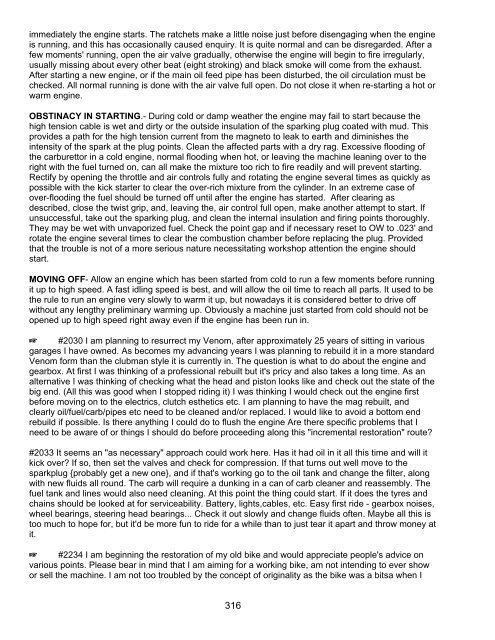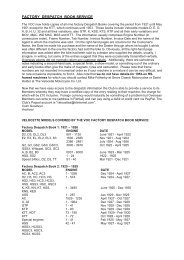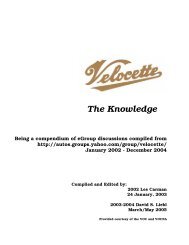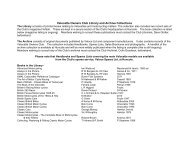The Knowledge - Velocette Owners Club
The Knowledge - Velocette Owners Club
The Knowledge - Velocette Owners Club
Create successful ePaper yourself
Turn your PDF publications into a flip-book with our unique Google optimized e-Paper software.
immediately the engine starts. <strong>The</strong> ratchets make a little noise just before disengaging when the engine<br />
is running, and this has occasionally caused enquiry. It is quite normal and can be disregarded. After a<br />
few moments' running, open the air valve gradually, otherwise the engine will begin to fire irregularly,<br />
usually missing about every other beat (eight stroking) and black smoke will come from the exhaust.<br />
After starting a new engine, or if the main oil feed pipe has been disturbed, the oil circulation must be<br />
checked. All normal running is done with the air valve full open. Do not close it when re-starting a hot or<br />
warm engine.<br />
OBSTINACY IN STARTING.- During cold or damp weather the engine may fail to start because the<br />
high tension cable is wet and dirty or the outside insulation of the sparking plug coated with mud. This<br />
provides a path for the high tension current from the magneto to leak to earth and diminishes the<br />
intensity of the spark at the plug points. Clean the affected parts with a dry rag. Excessive flooding of<br />
the carburettor in a cold engine, normal flooding when hot, or leaving the machine leaning over to the<br />
right with the fuel turned on, can all make the mixture too rich to fire readily and will prevent starting.<br />
Rectify by opening the throttle and air controls fully and rotating the engine several times as quickly as<br />
possible with the kick starter to clear the over-rich mixture from the cylinder. In an extreme case of<br />
over-flooding the fuel should be turned off until after the engine has started. After clearing as<br />
described, close the twist grip, and, leaving the, air control full open, make another attempt to start. If<br />
unsuccessful, take out the sparking plug, and clean the internal insulation and firing points thoroughly.<br />
<strong>The</strong>y may be wet with unvaporized fuel. Check the point gap and if necessary reset to OW to .023' and<br />
rotate the engine several times to clear the combustion chamber before replacing the plug. Provided<br />
that the trouble is not of a more serious nature necessitating workshop attention the engine should<br />
start.<br />
MOVING OFF- Allow an engine which has been started from cold to run a few moments before running<br />
it up to high speed. A fast idling speed is best, and will allow the oil time to reach all parts. It used to be<br />
the rule to run an engine very slowly to warm it up, but nowadays it is considered better to drive off<br />
without any lengthy preliminary warming up. Obviously a machine just started from cold should not be<br />
opened up to high speed right away even if the engine has been run in.<br />
L #2030 I am planning to resurrect my Venom, after approximately 25 years of sitting in various<br />
garages I have owned. As becomes my advancing years I was planning to rebuild it in a more standard<br />
Venom form than the clubman style it is currently in. <strong>The</strong> question is what to do about the engine and<br />
gearbox. At first I was thinking of a professional rebuilt but it's pricy and also takes a long time. As an<br />
alternative I was thinking of checking what the head and piston looks like and check out the state of the<br />
big end. (All this was good when I stopped riding it) I was thinking I would check out the engine first<br />
before moving on to the electrics, clutch esthetics etc. I am planning to have the mag rebuilt, and<br />
clearly oil/fuel/carb/pipes etc need to be cleaned and/or replaced. I would like to avoid a bottom end<br />
rebuild if possible. Is there anything I could do to flush the engine Are there specific problems that I<br />
need to be aware of or things I should do before proceeding along this "incremental restoration" route?<br />
#2033 It seems an "as necessary" approach could work here. Has it had oil in it all this time and will it<br />
kick over? If so, then set the valves and check for compression. If that turns out well move to the<br />
sparkplug {probably get a new one}, and if that's working go to the oil tank and change the filter, along<br />
with new fluids all round. <strong>The</strong> carb will require a dunking in a can of carb cleaner and reassembly. <strong>The</strong><br />
fuel tank and lines would also need cleaning. At this point the thing could start. If it does the tyres and<br />
chains should be looked at for serviceability. Battery, lights,cables, etc. Easy first ride - gearbox noises,<br />
wheel bearings, steering head bearings... Check it out slowly and change fluids often. Maybe all this is<br />
too much to hope for, but it'd be more fun to ride for a while than to just tear it apart and throw money at<br />
it.<br />
L #2234 I am beginning the restoration of my old bike and would appreciate people's advice on<br />
various points. Please bear in mind that I am aiming for a working bike, am not intending to ever show<br />
or sell the machine. I am not too troubled by the concept of originality as the bike was a bitsa when I<br />
316





